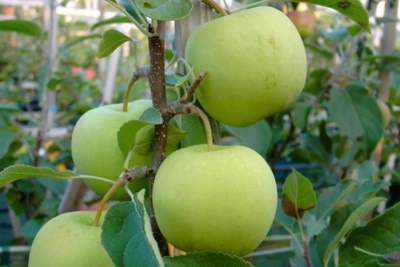
- Taste: sweet, sourness present
- Fruit weight, g: 130-160
- Yield: at the age of 6 years harvest - 15-20 kg
- The beginning of fruiting varieties: for 3-4 years
- Ripening terms: late winter
- Removable maturity: early October
- Duration of the consumer period: October-March
- Appointment: universal
- Growing regions: middle zone of Russia, western Belarus
- Name synonyms: Kastel, Polish sugar
To get a good apple harvest, trees need proper care. A little patience, and a few years after planting on an apple tree of the Kostelya variety, delicious, amazing presentation fruits appear.
Breeding history of the variety
The complete history of the breeding of the described variety is unknown. For the first time, the tree was written in the chronicle of Jan III Sobieski, who, in turn, was the Polish king. He ruled in the middle of the 17th century, thus the Kostel variety is over 300 years old.
You can find slight differences in the names if you study different sources. The most correct is the Kashtelskaya or Polish sugar apple tree.
In Russia, the variety began to be actively cultivated at the end of the 19th century. Koshtel was cultivated as a commercial variety until 1948. Now it is not zoned, therefore there is no information in the State Register.
Description of the variety
This is not an ornamental tree, the maximum height is 3 meters. The crown is formed wide and spreading. This is a medium-sized plant.
Features, pros and cons
The variety has many advantages:
small size;
grows in any conditions;
winter-hardy tree;
you do not need to often water and feed with fertilizers;
apples are large, rich in ascorbic acid.
If we talk about the shortcomings, then this is a late fruiting period.
Ripening and fruiting
The variety has a late winter ripening period, removable maturity occurs in early October. The duration of the consumer period is from October to March.
The tree begins to bear fruit only 3-4 years after planting.
Growing regions
Koshtel's apple tree is grown in central Russia and in the west of Belarus. The plant takes root well in the Bryansk and Ryazan regions, you can find it in Moscow and the Moscow region, as well as in the Leningrad region. The variety is also found in the North Caucasus, in the Crimea. As you can see, the variety has a rich geography.
Yield
The yield should be assessed when the tree is already mature. Such maturity occurs 6 years after planting. From one plant, you can collect from 15 to 20 kg of ripe, tasty fruits.
Fruits and their taste
Apples of this variety are excellently transported. This is a fast-growing plant for universal fruit purposes. Apples are green, even when ripe, have a rounded shape. Each weighs from 130 to 160 grams.
The skin of the fruit is smooth, there are multiple light spots under the skin. Inside hides a green, dense pulp, which is moderately sugary.
The taste is quite sweet, there is a slight sourness.

Growing features
Apple trees need a lot of sun. At least 8 hours a day.
For the successful cultivation of the variety, fertile soil is needed.It is best to do a soil test before planting to make sure the trees feel comfortable and do not need nutrients. For apple trees, the pH should be between 6.0 and 7.0. It is advisable to add compost and bone meal to the soil beforehand.



Pollination
Without pollinators, the gardener will not get tasty apples, so it is better to plant trees near an area where there are many bees and butterflies.
Top dressing
Top dressing is a concentrated dose of nutrients. Nutrient management is a long-term solution to ensure consistently good yields.
If the soil is low in phosphorus or calcium, sprinkle the soil around with a mixture of bone meal and compost. A thick layer of mulch is laid on top. Straw or wood chips are suitable. It helps prevent weeds from growing around trees and keeps moisture in the ground.

Frost resistance
The described variety has high frost resistance, therefore it grows in many regions of our country.

Diseases and pests
Among the insects that often infect the apple tree, there are moth larvae. These are small worms that burrow into apples. An adult butterfly lays an egg on the fruit, a worm hatches from it. When the affected apple falls, the insect crawls out of it, crawls to the tree and finds a secluded place. There it unwinds a cocoon to turn into a moth.
In the spring, you can fill the container with bait and hang it on a tree:
one part apple cider vinegar;
a third of a glass of molasses;
1/8 teaspoon of ammonia;
two cups of water.
Another problem is aphids. It is better to use biological protection from it, namely: to attract beetles that eat it. If the young tree is severely infested, it is sprayed with a mixture of peppermint oil and rosemary.
Insecticides can be used against any insects. But, this is not the only problem that a gardener has to face. Black rot often appears on trees.
As the name suggests, this fungus causes apples to turn black and rot.Fallen fruits and leaves must be immediately removed and burned. Infected shoots develop red ulcers on the branches. Such shoots are not placed in compost, otherwise spreading cannot be avoided.
This variety has a high scab resistance.

The apple tree is a popular fruit crop among gardeners. It can be found in many summer cottages. But at the same time, such trees are often affected by various diseases. It is very important to recognize the disease in time and carry out the necessary procedures for a speedy recovery. Otherwise, the fruits will be spoiled, and the tree itself may die altogether.












































































